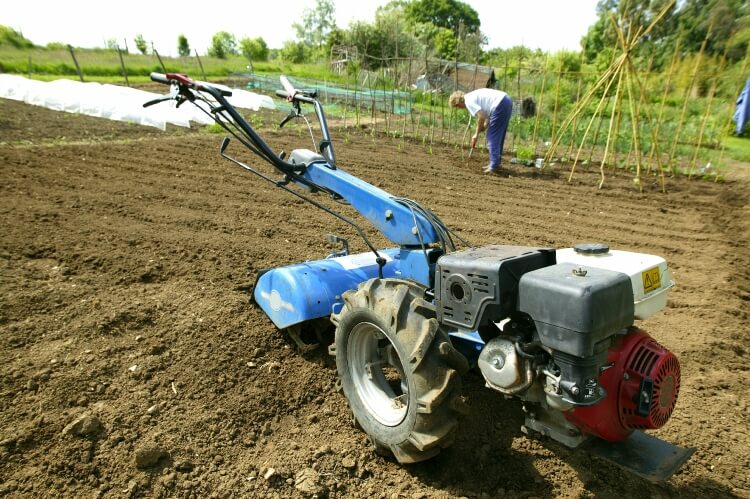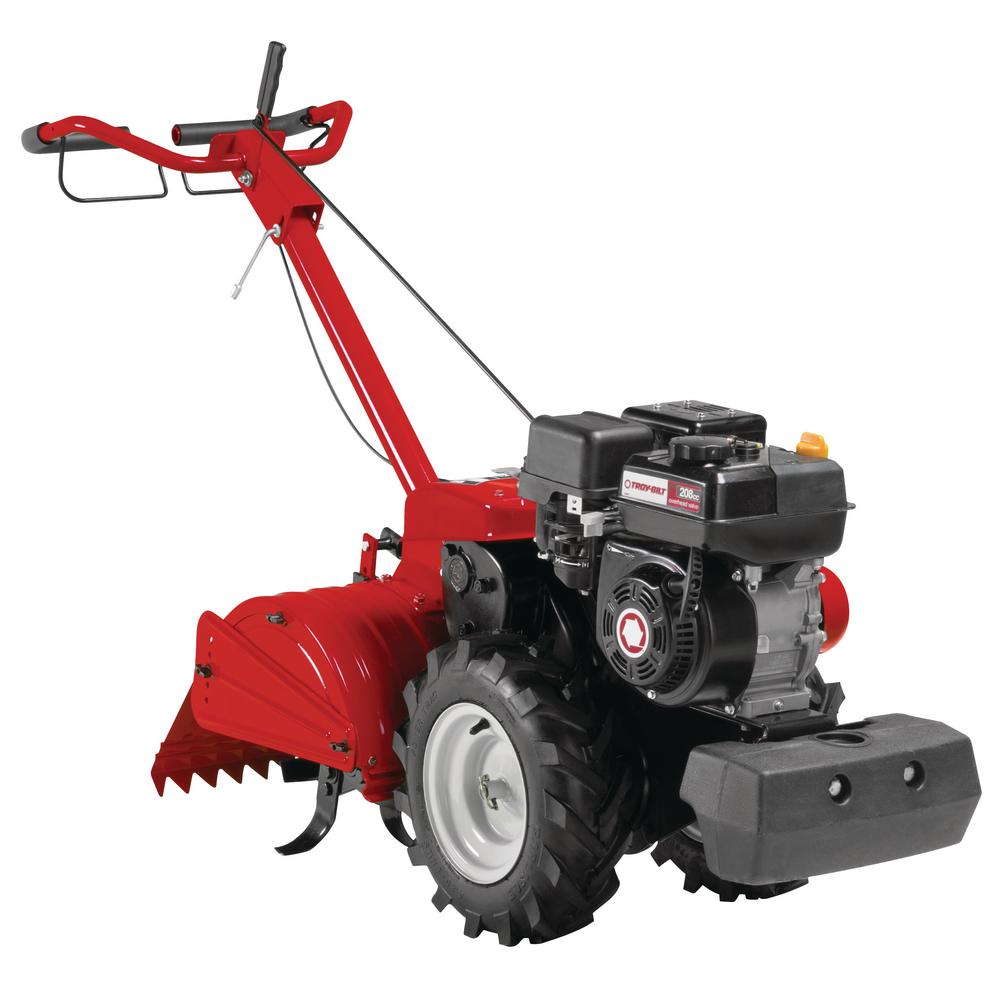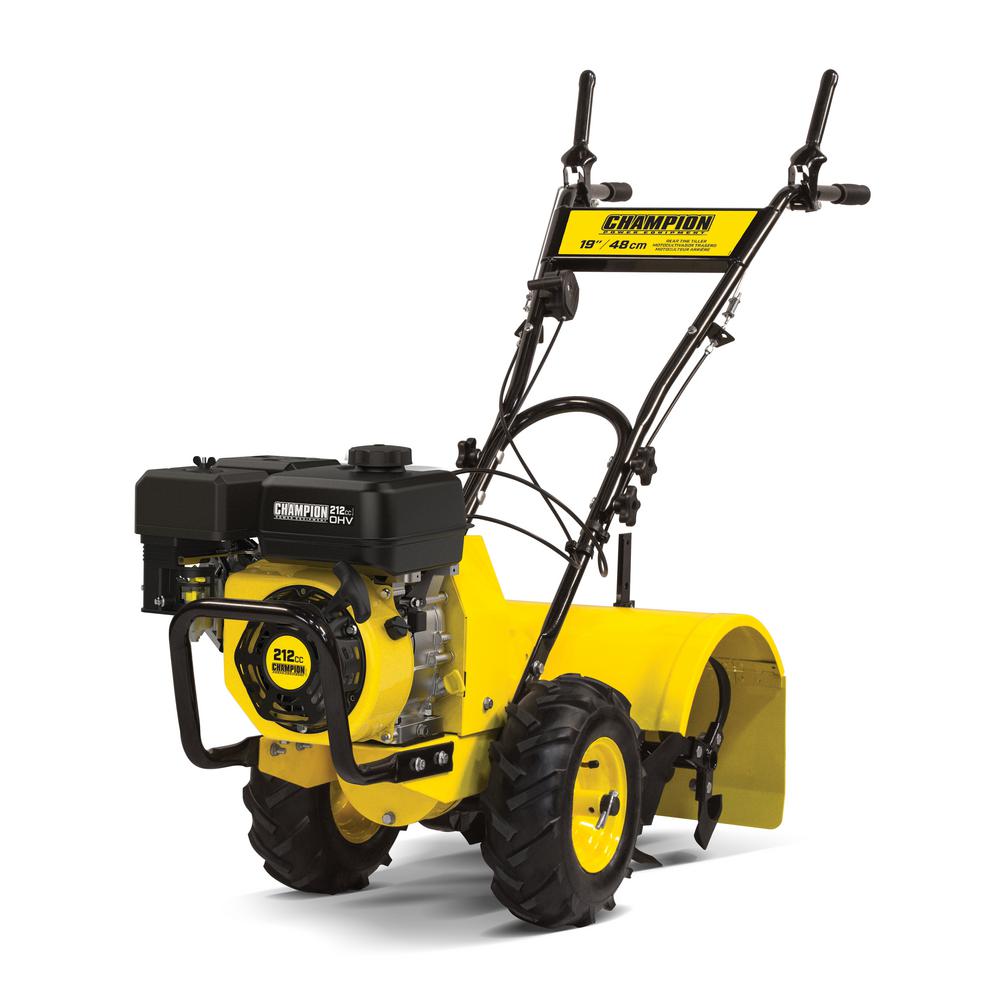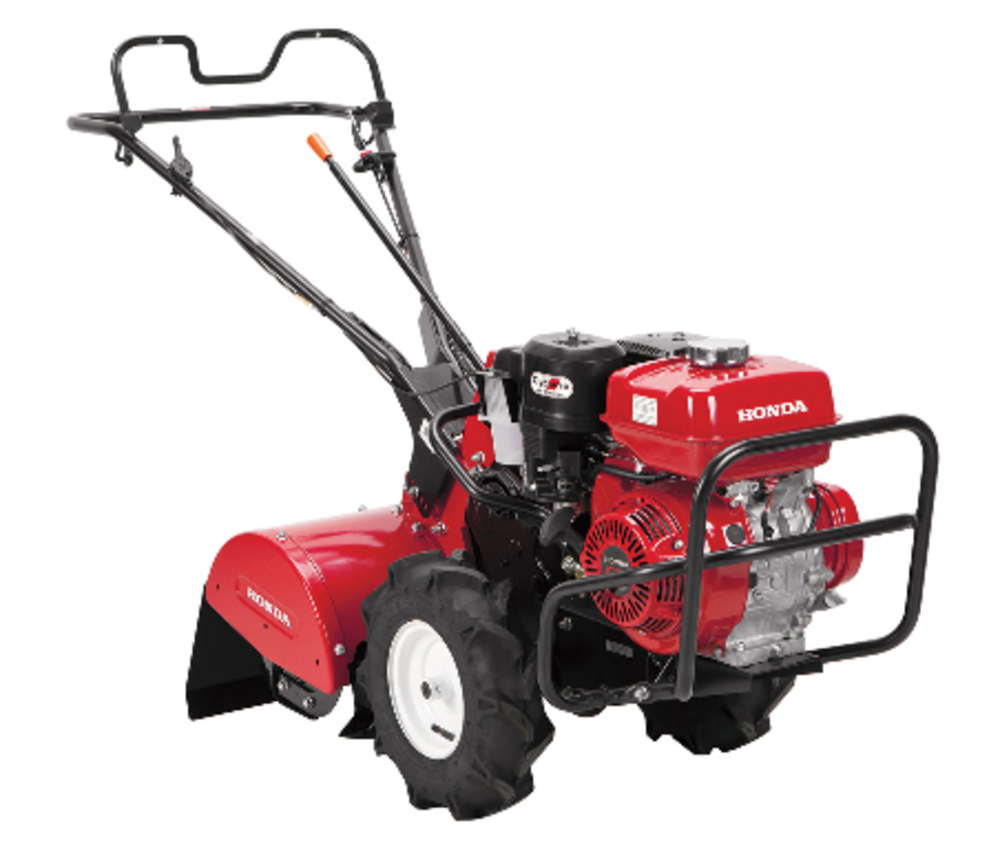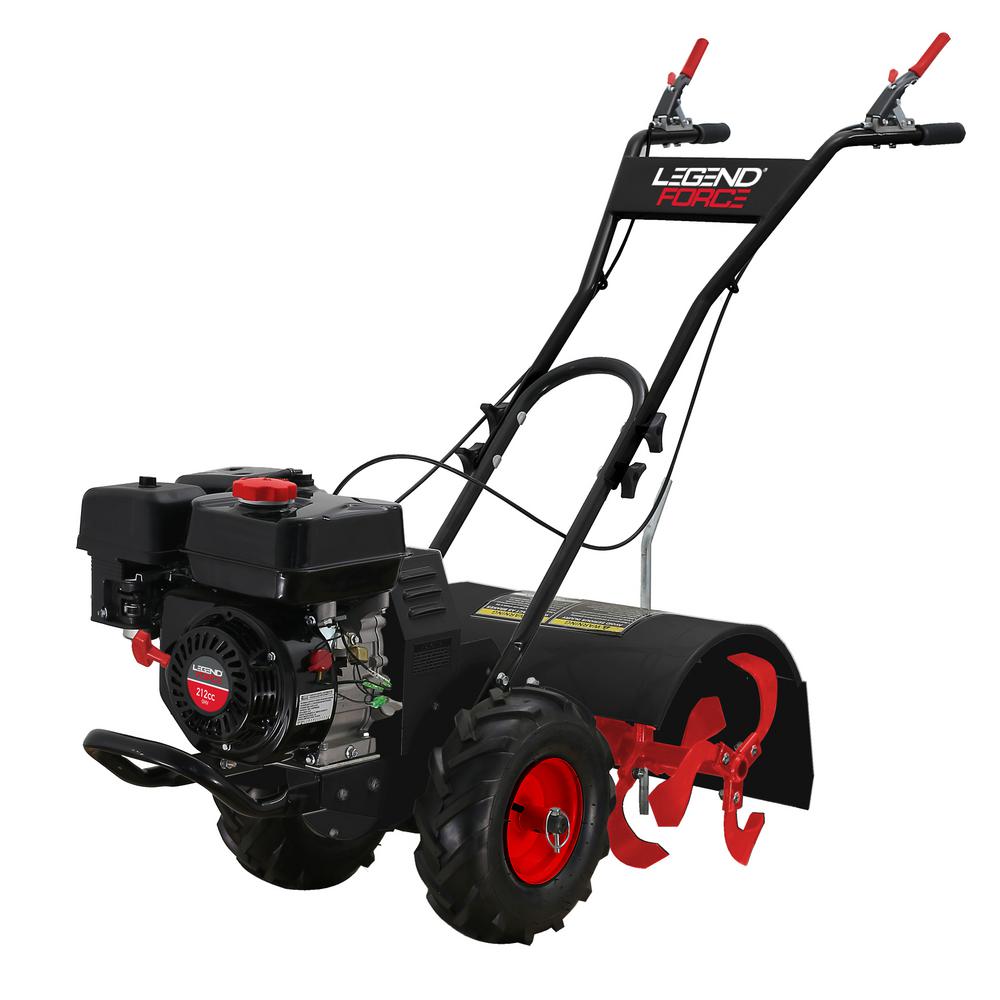When you’re planning a task like breaking ground for a new garden or tearing through tough clay or stony soil, a rear tine tiller is the tool for the job.
Rear tine tillers have the tilling blades, known as tines, located behind the wheels and engine. This construction gives the tiller excellent stability and allows it to dig powerfully into the ground. Almost all rear tine tillers have gas engines, typically ranging from 99cc to over 300cc in displacement. Rear tine tillers are heavy pieces of equipment that often weigh between 150 to 270 pounds, but fortunately, most have self-propelled wheels.
In this article, you’ll learn about our 7 picks for the best rear tine tiller, with choices from various price points. You’ll also get some expert input as to what features are the most important to look for while shopping.
If you’re in a hurry, this table summarizes the key points of the rear tine tillers we’ll be looking at today:
Earthquake Victory | Troy-Bilt Mustang | Earthquake Pioneer | Champion Power Equipment | Yard Force YF20-RTT | Honda FRC800K1AN | Legend Force LF20212RT | |
Engine Size | 212cc Viper engine | 208cc Troy-Bilt engine | 99cc Viper engine | 212cc Champion engine | 208cc Briggs and Stratton engine | 270cc Honda engine | 212cc Legend Force engine |
Tilling Width | 16 inches | 18 inches | 17 inches | 19 inches | 20 inches | 20 inches | 20 inches |
Tilling Depth | 10 inches | 7.5 inches | 11 inches | 8 inches | 14 inches | 12 inches | 6.5 inches |
Tine Rotation | Counter rotation | Dual rotation | Dual rotation | Counter rotation | Counter rotation | Standard rotation | Standard rotation |
Number of Tines | 6 | 12 | 4 | 4 | 4 | Not stated | 4 |
Transmission | Gear | Gear | Gear | Gear | Gear | Gear and chain | Belt |
Weight | 163 pounds | 269 pounds | 160 pounds | 161 pounds | 144 pounds | 265 pounds | 159 pounds |
Self Propelled | Yes | Yes | Yes | Yes | Yes | Yes | No |
Tire Size/Type | 13-inch pneumatic | 16-inch pneumatic | Airless rubber | 13-inch pneumatic | 13-inch pneumatic | 14-inch pneumatic | 13.5 inch pneumatic |
Warranty | 5-year limited | 2-year limited | 5-year limited | 2-year limited | 2-year limited | 3-year limited | 2-year limited |
Let’s jump in!
Table of Contents
1. Earthquake Victory Rear Tine Tiller
**Best Overall Rear Tine Tiller

- Engine size: 212cc 4-stroke Viper engine
- Tilling width: 16 inches
- Tilling depth: 10 inches
- Tine rotation: Counter rotation
- Transmission: Gear driven
- Number of tines: 6
- Weight: 163 pounds
- Self-propelled: Yes
- Tire size and type: 13-inch pneumatic tires
- Warranty: 5-year limited warranty
The Earthquake Victory comes in as our top pick for the best rear tine tiller for a few reasons:
- Ideal for any garden job, both breaking new ground and maintaining an existing garden
- Small size is well-designed and easy to handle
- Long warranty period with U.S.-based customer service
- Affordable price point
Thanks to counter-rotating tines, a powerful engine and a thoughtful design, the Victory offers outstanding performance in a small package.
Even though the engine is large, Earthquake gave the Victory a smart design that balances the weight well. This makes the tiller easy to maneuver around the garden with less corrective effort on your part. Strong, forged steel tines dig up to 10 inches into the soil, and you’ll leave a 16-inch tilled path in your wake.
One of the most notable features of this tiller is the instant reverse lever. Instead of performing an awkward turn at the end of a row or skipping those odd spaces because they’re just too tight, engage the reverse lever to instantly switch the wheel direction.
The handlebar features a full-length design engineered for ease of use and one-handed driving. Adjust the handlebar height to one of three height settings to tailor it to your liking.
The 13-inch pneumatic tires have an aggressive lug pattern for excellent traction. However, if you’re working with fine, already-broken soil (think mid-season tilling between rows/weed removal), you may have to help the Victory along by pushing it at times.
For maximum engine lifespan and easy, 1-pull starting, always use the gas shut-off lever when powering your tiller down. This drains gas from the engine, preparing it for a fresh start next time you have some work to do.
One thing that would have been a welcome addition is a neutral gear where the self-propelled wheels are engaged but the tines do not spin. As it is, removing a lock pin on the wheels allows the wheels to spin freely when the engine is not engaged. It’s pretty easy to use freewheel mode, but you’ll have to use your own elbow grease to get your tiller to the garden bed.
If you’d like to see the Victory in action, HouseBarons has a great demonstration video:
Pros
Cons
2. Troy-Bilt Mustang Rear Tine Tiller
**Best Rear Tine Tiller for Breaking New Ground
- Engine size: 208cc 4-stroke Troy-Bilt engine
- Tilling width: 18 inches
- Tilling depth: 7.5 inches
- Tine rotation: Dual rotation
- Transmission: Gear driven
- Number of tines: 12
- Weight: 269 pounds
- Self-propelled: Yes
- Tire size and type: 16-inch pneumatic tires
- Warranty: 2-year limited warranty
For medium to large gardens, the Troy-Bilt Mustang offers a nice combination of power and versatility at a moderate price point. Plus, Troy-Bilt products are made in America with domestic and global components.
Thanks to dual-rotating tines and a heavy frame that allow it to dig deeply into the soil, the Mustang is perfect for establishing new gardens, even if your soil conditions are hardened clay or stone-riddled. For even greater efficiency, the BOLO tines feature a patented shape that effectively slices, turns and mixes the soil.
But the Mustang is also great for refining broken soil or maintaining existing gardens. After tearing through virgin soil to break it up, switch over to standard (forward) rotation to create a smooth, plantable surface.
Adjustable side shields are a great addition to keep your tilled soil where it belongs, namely in your tiller’s wake instead of spraying out the sides.
The pneumatic tires are supersized 16 inches in diameter and 4 inches in width, so you shouldn’t run into trouble getting good traction even on rough or otherwise challenging ground.
Each of the two hand grips has independent power, so you can use this tiller with just one hand if the situation calls for it. And despite the large size and heavy weight, Troy-Bilt specifically designed the Mustang to be balanced and easy to control one-handed. Padded hand grips are a nice extra touch for comfort.
At just shy of 270 pounds, this tiller qualifies as a heavy-weight piece of equipment. Fortunately, if your garden is a distance from your storage area or you need to transport your tiller, you won’t have to rely on muscle power alone. Shift into neutral gear to disengage the tine rotation while still powering the wheels forward or reverse, letting the self-propel do the heavy work for you.
One thing we really like is that the gear shifter is located on the handlebar, so you don’t have to do any reaching to switch between gears or tine rotation direction. From the gear shift panel, you can select standard (forward) or counter tine rotation, neutral or power reverse.
But while the convenient positioning is great, changing from one gear to another can be finicky, especially when the unit is new. And additional speed settings beyond a single basic option would have been a welcome addition.
Pros
Cons
RELATED: Some outdoor jobs call for a little less power than a rear tine tiller provides. In this case, a front tine tiller might be a better choice!
3. Earthquake Pioneer Rear Tine Tiller
**Best Dual Rotating Rear Tine Tiller

- Engine size: 99cc 4-stroke Viper engine
- Tilling width: 17 inches
- Tilling depth: 11 inches
- Tine rotation: Dual rotation
- Transmission: Gear driven
- Number of tines: 4
- Weight: 160 pounds
- Self-propelled: Yes
- Tire size and type: Airless rubber tires, diameter not stated
- Warranty: 5-year limited warranty
The true stand-out feature of the Pioneer is the dual tine rotation feature. This makes the Pioneer incredibly versatile, and it’s just as appropriate for busting up tough sod for a new garden as it is preparing a level, smooth planting bed.
And making the switch between the tine rotation options is simple and only takes a few seconds. The gear shifter is located right beside the wheel, making the large, bright-green handle readily within reach and easy to use.
One more point on the topic of gears. Earthquake included a drive-only gear that allows you to engage the wheels’ self-propel without engaging tine rotation. If you’ll be moving your tiller from one place to another or loading it onto a trailer, this makes transportation a breeze.
The Pioneer is a great balance between power and maneuverability. Earthquake gave the Pioneer a 99cc engine, which is smaller than many of its comparably-sized competitors. However, the tiller frame is designed for maximum efficiency, so the engine provides a perfect amount of power while also being lightweight. Also, the transmission housing is located in the center of the frame, creating a low center of gravity for excellent stability and maneuverability.
Just like the Victory model in spot #1, Earthquake also built an instant reverse lever into the Pioneer. This lets you easily back out of corners or small spaces quickly and with no fuss. The reverse lever is located right below the hand grips, so it’s within easy reach at all times.
You can operate the Pioneer from either of the two hand grips, allowing you to use your tiller one-handed if needed. This comes in handy in tight spaces and when you want to avoid stepping in your fluffy, planting-ready soil.
Large, airless tires mean that you’ll never have to deal with a flat tire when you’re in the middle of a job. And don’t worry that the solid design means compromised traction- the wide size and deep lug pattern help your tiller grip the soil and move confidently forward.
Earthquake offers a 5-year limited warranty on the Pioneer, which is industry-leading in terms of length. And all customer service is based out of their Northern Wisconsin office.
One small drawback to point out is that there is only one speed in both forward and reverse. However, that doesn’t affect the tiller’s performance.
Pros
Cons
RELATED: For small garden jobs where you don’t want to haul out the big rear tine tiller, a smaller electric model might be a perfect fit. To see our top picks, visit our post on electric tiller reviews!
4. Champion Power Equipment Rear Tine Tiller
**Best Budget Rear Tine Tiller
- Engine size: 212cc 4-stroke Champion engine
- Tilling width: 19 inches
- Tilling depth: 8 inches
- Tine rotation: Counter rotation
- Transmission: Gear driven
- Number of tines: 4
- Weight: 161 pounds
- Self-propelled: Yes
- Tire size and type: 13-inch pneumatic tires
- Warranty: 2-year limited warranty
If you have a small to medium-sized garden and don’t want to invest a ton of cash into a tiller, this model from Champion Power Equipment may be a good fit.
A powerful 212cc engine powers strong, 13.8-inch hardened steel tines. And at 19 inches, this tiller produces a generous tilling path with each pass. For extra durability, Champion Power Equipment built the transmission from cast-iron gears. Also, the transmission is protected by a sturdy cast-iron housing unit.
The tines spin in a counter-rotating pattern, allowing you to dig deeply into the soil and break up hard, compacted earth. This is ideal for breaking ground for a new garden, and you can also use the tiller for annual garden soil turning in the spring or late fall.
There is no neutral gear setting, which would have been nice. But at this price point, it’s really not a feature you can expect to see. However, you can easily put your tiller into freewheel mode when the engine is not engaged. Pull the cotter pin from the wheel axle to allow the wheels to spin freely, allowing you to push your tiller across open ground or onto a trailer.
One concern to point out is the lack of side shields. Given the tine construction, soil tends to get pushed out to the sides rather than behind the tiller. This could lead to plants/other objects getting sprayed with dirt or you having to rake the garden after tilling to get a level surface.
NOTE: Some product descriptions list this tiller as “dual rotation.” It is not- it is a counter-rotating model. While it’s true that the tines will spin forward when you move the tiller in reverse, this machine isn’t designed to be used in reverse for any longer than it takes to back out of a corner. So this cannot truthfully be called a dual-rotation tiller.
Pros
Cons
RELATED: If you’d like to check out some more budget-friendly tillers, stop by our on rear tine models that cost less than $1000.
5. Yard Force YF20-RTT Rear Tine Tiller
**Best Budget Rear Tine Tiller Runner-Up
- Engine size: 208cc 4-stroke Briggs & Stratton CR950 engine
- Tilling width: 20 inches
- Tilling depth: 14 inches
- Tine rotation: Counter rotation
- Transmission: Gear driven
- Number of tines: 4
- Weight: 144 pounds
- Self-propelled: Yes
- Tire size and type: 13-inch pneumatic tires
- Warranty: 2-year limited warranty
With lots of useful features and a very attractive price point, the YF20-RTT is another awesome option for a solid tiller that won’t break the bank. In fact, the only reason we didn’t rank this model as the top budget pick is that it’s only been on the market for a fairly short time, and how it performs over the long term remains to be seen. However, the initial evidence looks favorable!
One outstanding feature of this tiller is the aggressive tilling width and depth. The YF20-RTT offers a 20-inch working width, which is at the top of the scale for the models we’re looking at here today. And as for the working depth, this tiller breaks up soil as much as 14 deep, which blows the competition out of the water by at least a couple of inches (and usually more like 6+ inches!).
So if you’ve got a large garden space to work, these dimensions can help seriously cut down on your overall working time.
As for the engine, 208cc is a pretty common displacement capability for rear tine tillers, packing plenty of power to work even compacted clay or stony/weedy soil. And it’s a Briggs and Stratton engine build, so that adds an extra measure of reliability and peace of mind.
Yard Force kept it simple on the transmission construction: One speed forward and one speed in reverse. Power reverse is a nice feature that makes getting out of corners or backing onto a trailer nice. To engage reverse, just squeeze the lower handle underneath the right handgrip, and the wheels will start to spin in reverse.
To help protect the engine housing from damaging accidental bumps, the generous front guard bar stands in the way between your tiller and trees, fences, vehicles, etc. And if you plan on hauling your tiller from one place to another, the guard bar also lets you secure your tiller to the trailer or truck bed.
One thing to keep in mind is that the YF20-RTT does not have a neutral gear, meaning that you cannot disengage the tines while the engine is on. However, there is a freewheel mode where you can unlock the wheels to push your tiller manually. While neutral gear is always nice and not having it is a bit of a bummer in terms of transport, it’s not a feature that you can expect to see very often at this price point.
Pros
Cons
6. Honda FRC800K1AN Rear Tine Tiller
**Best Heavy-Duty Rear Tine Tiller
- Engine size: 270cc 4-stroke Honda GX240 engine
- Tilling width: 20 inches
- Tilling depth: 12 inches
- Tine rotation: Standard (forward) rotation
- Transmission: Gear and chain driven
- Number of tines: Not stated
- Weight: 265 pounds
- Self-propelled: Yes
- Tire size and type: 14-inch pneumatic tires
- Warranty: 3-year limited warranty
If you have a small/hobby farm or a large garden to tend to, the Honda FRC800K1AN tiller is a beast that can handle the toughest jobs.
Honda has a well-deserved reputation for designing high-quality engines that are built to last, and it’s not uncommon for a Honda tiller to last several years or even decades. This model packs a powerful 270cc engine along with commercial-grade materials and construction. To further extend the engine’s life, Honda also included a Cyclone air filter that traps debris and dust before they can do any harm.
The chain-driven transmission offers three forward speeds and one reverse speed, so you can get your tilling done at the speed appropriate to the ground you’re working with. The handlebar features a full-length design that lets you control your tiller from either side, and there are four height adjustments to suit your liking.
A generously-sized front guard bar protects the engine from contact damage and makes it easy to secure your tiller for transport. And speaking of transport, shift into the transport gear to shut off tine rotation and still use the self-propelled wheels to easily and safely move your tiller from one spot to another.
We really appreciate the safety features that Honda built into this tiller:
- An emergency shut-off switch lets you instantly kill the engine in the event of a sudden obstruction.
- Automatic tine lock-out when you put the tiller into reverse
- Large shields in the rear and sides of the tine housing reduce the chances of flying debris
One thing to be aware of: This is a standard (forward) rotating tiller, and counter-rotation is not an option. However, that doesn’t seem to stop this tiller from tearing up even challenging ground quickly and effectively.
While this tiller is a true beast that can stand up to the most difficult conditions- that power comes at a price. This tiller is quite an investment, but it should serve you well for many years to come.
Pros
Cons
7. Legend Force LF20212RT Rear Tine Tiller
**Best Rear Tine Tiller Under $600
- Engine size: 212cc 4-stroke Legend Force engine
- Tilling width: 20 inches
- Tilling depth: 6.5 inches
- Tine rotation: Standard (forward) rotation
- Transmission: Belt driven
- Number of tines: 4
- Weight: 159 pounds
- Self-propelled: No
- Tire size and type: 13.5-inch pneumatic tires
- Warranty: 2-year limited warranty
When you’re looking to save some cash and get a tiller that gets the job done without all the extra bells and whistles, the Legend Force LF20212RT Rear Tine Tiller fills the bill.
But despite its modest price tag, this tiller packs a surprising amount of power and function. The 212cc engine is on par with more expensive models, as is the wide 20-inch tilling path. With this tiller, you should have no trouble making short work of small to medium gardens.
The tines rotate in a forward direction only, so this tiller produces a fine, even soil texture that’s ready for planting. Also, the forward rotation is ideal for mid-season weed removal between garden rows or individual plants, if you’ve 20 inches of clearance between plants.
Rugged 13.5-inch tires produce good traction and roll easily over bumps and ruts. And an adjustable tilling depth gauge lets you select your preferred setting, up to 6.5 inches deep.
Of course, at this lower price point, there are a few features/capabilities that just aren’t there. While this tiller should do a great job on previously-broken or loose, sandy soil, you’ll probably struggle to break ground for a new garden or work with challenging conditions.
Also, be aware that this model does not have self-propel.
All in all, the Legend Force LF20212RT should be a great choice for small spaces and routine garden maintenance while keeping some extra cash in your pocket.
Pros
Cons
RELATED: Wondering what exactly sets front tine tillers apart from rear tine ones? Stop by our front vs rear tine tiller comparison post to learn more!
Shopping for the Best Rear Tine Tiller: Buying Guide
Now that you’ve had the chance to learn about the details of each model, let’s take a closer look at the key feature and how they impact your garden work. We
Tine Rotation
- Standard Rotation
- Counter Rotation
- Dual Rotation
Standard Rotation. In standard rotation, the tines spin forward, in the same direction as the wheels and towards the front of the tiller. This forward motion helps pull the tiller along, and it also creates a fine, even soil texture.
While standard tine rotation will work for breaking new ground, you may have to invest more time and effort to get the job done. The most ideal situation for forward-rotating tines is annual spring soil turning in established gardens.
Counter Rotation. Counter-rotating tines spin in the opposite direction, against the forward motion of the wheels and towards the back of the tiller. The opposite directions create more friction, allowing you to dig deeply into the soil and power through tough obstacles.
If you’re just starting a new garden on unbroken ground, a tiller with counter-rotating tines is the best choice.
Dual Rotation. Tillers that offer dual direction tines are the best of both worlds, and they are the most versatile machines that can handle all your garden jobs. These tillers have two tine-direction settings, allowing you to switch between the tines rotating forward or backward.
Dual direction tillers are great for establishing new gardens on virgin ground, and they can also produce a fine, planting-ready soil surface, all in one machine.
Engine
At the time of publishing this article, all rear tine tillers have gas engines. Although that could change in the near future as battery technology continues to advance.
The most common engine type is a 4-stroke design, meaning that it takes four revolutions to achieve one power stroke. Other gas tools, like string trimmers or leaf blowers, often use a 2-stroke engine, which only requires two revolutions per one power stroke.
2-stroke engines tend to have more power up-front, but there are plenty of advantages to a 4-stroke engine:
- No need to mix oil and gas
- Requires less maintenance
- Tends to have a longer lifespan
- Produces fewer emissions
Especially when you’re investing in a large piece of garden equipment like a rear tine tiller, that longer lifespan and easier maintenance is a true blessing.
Wheels/Tires
No one wants to get mired down in the dirt while you’re working, and the larger the tires and wheels, the easier it will be to roll over bumps and ruts. Most rear tine tillers have tires that are at least 13 inches in diameter.
While the majority of rear tine tillers have pneumatic tires, there are a few that feature an airless design. The advantage of airless construction is the elimination of getting a flat tire. However, while airless tires typically feature an aggressive lug pattern for traction, they still may not be able to grip the ground as well as pneumatic ones do.
Also, another function of pneumatic tires is shock absorption, so you may get a few more jolts traveling up your arm with airless tires.
Transmission
Transmissions on rear tine tillers come in two types:
- Gear driven transmissions use a series of metal gears to shift from one gear setting to another.
- Belt driven transmissions use a system of pulleys and belts to handle the gear shifting.
We asked Sydney Brisco, home improvement expert and founder of Just A Homeowner, for her input on how these two transmission types differ.
“Gear driven transmissions are more difficult to maintain, which also makes it more expensive. These transmissions will need to be disassembled once a season to be examined and repaired if necessary.”
Gear driven transmissions use gears of various sizes and configurations to change from one gear setting to another. This design loses less power to friction, making it a highly efficient system.
“Belt driven transmissions are easier to maintain, since you just have to make sure the belt is tensioned correctly and not worn out. However, the belt does need to be replaced every once in a while and, depending on the model, it can be difficult to find the appropriate belt.”
According to Tec-Science, belt driven transmissions use friction locking to function, and maintaining the proper tension is critical to performance. If you choose a model with a belt driven transmission, make a belt inspection a part of your pre-use check every time you use your tiller.
Depth Adjustability
Almost all rear tine tillers offer an adjustable depth setting, letting you set your desired tilling depth and maintain an even surface over your entire garden.
Most of the time, adjusting the working depth involves a drag bar located on the rear guard housing that covers the tines. Move the bar higher or lower according to your preference, and lock it in place with a bolt or pin. The drag bar’s setting dictates how far the tines can dig down into the ground.
Most rear tine tillers have a working depth of at least 6 inches, and the maximum depth capability is usually between 12 and 14 inches.
However, keep in mind that you probably won’t be able to till at max depth on your first pass over the garden especially if you’re breaking new ground. The better strategy is to set your tiller to a more shallow setting, and progressively get deeper on subsequent passes.
Tilling Width
To state the obvious, the wider your tiller’s working path is, the shorter the time you’ll spend covering ground.
Most rear tine tillers are between 12 and 24 inches in width, and those few inches can definitely add up over time. If you’ve got a large garden plot to work, a wider tiller will save you considerable time.
RELATED: Stop by our post on top tillers for breaking new ground to see models that are perfect for establishing a spacious new garden or a single small bed.
Frequently Asked Questions about Rear Tine Tillers
Final Thoughts
We hope you’ve found this list helpful, and that you now have a better idea of what features are most important to helping you achieve the garden or landscape of your dreams.
Do you have any other questions about rear tine tillers? Are there any models you’d like to see included on the list, or do you have any helpful tilling tips to share? We learn best as a community, so we’d love to hear from you in the comments!

